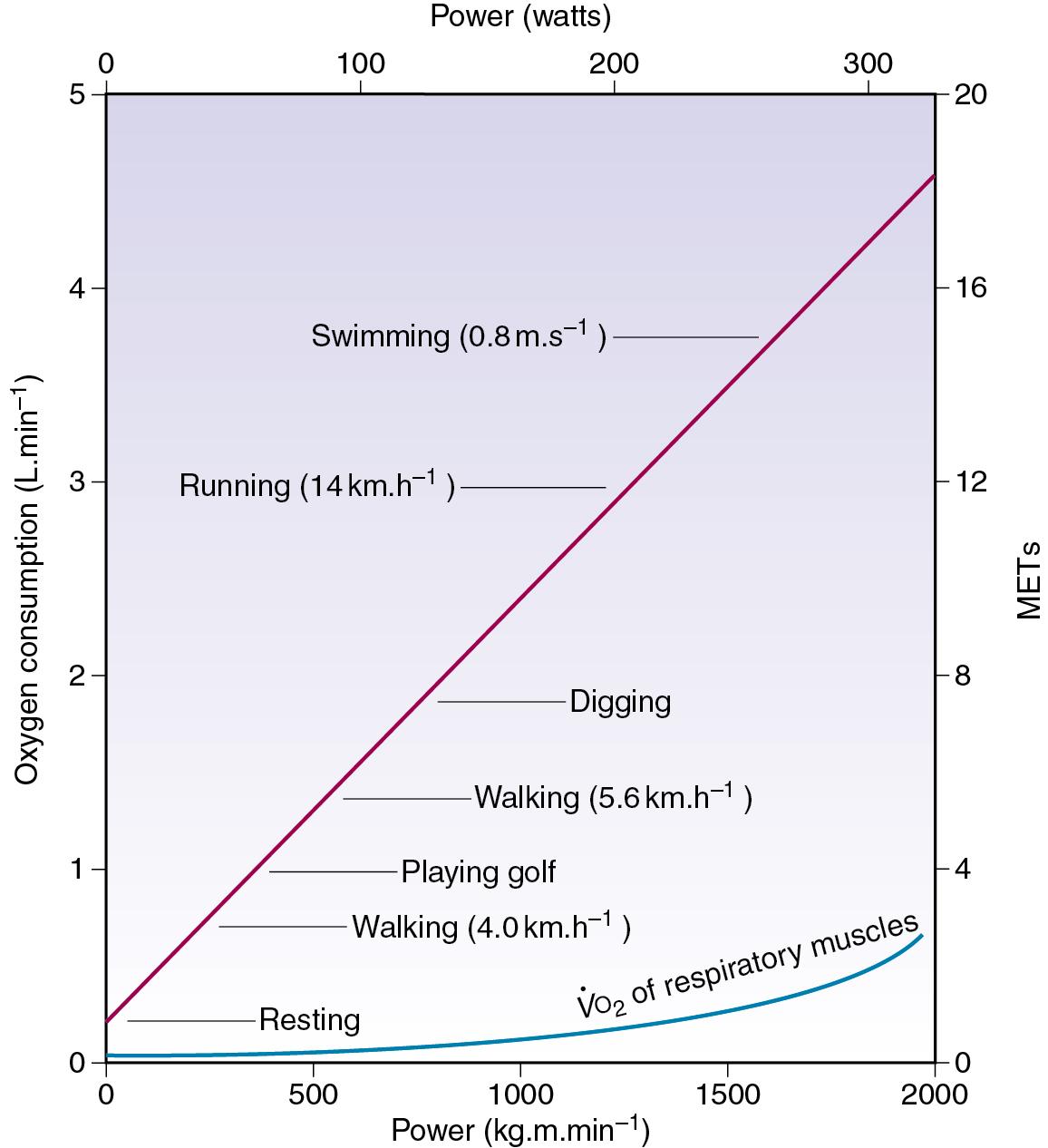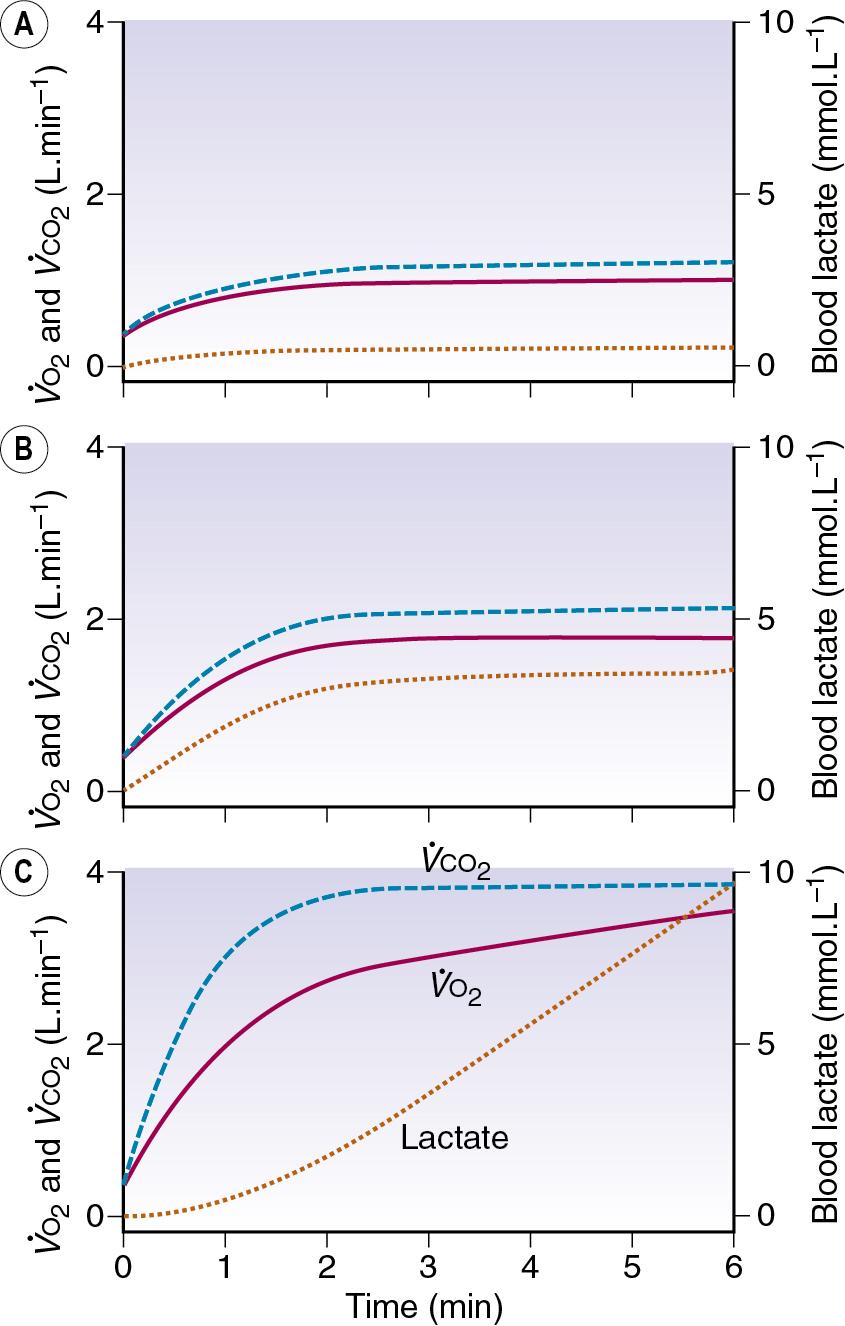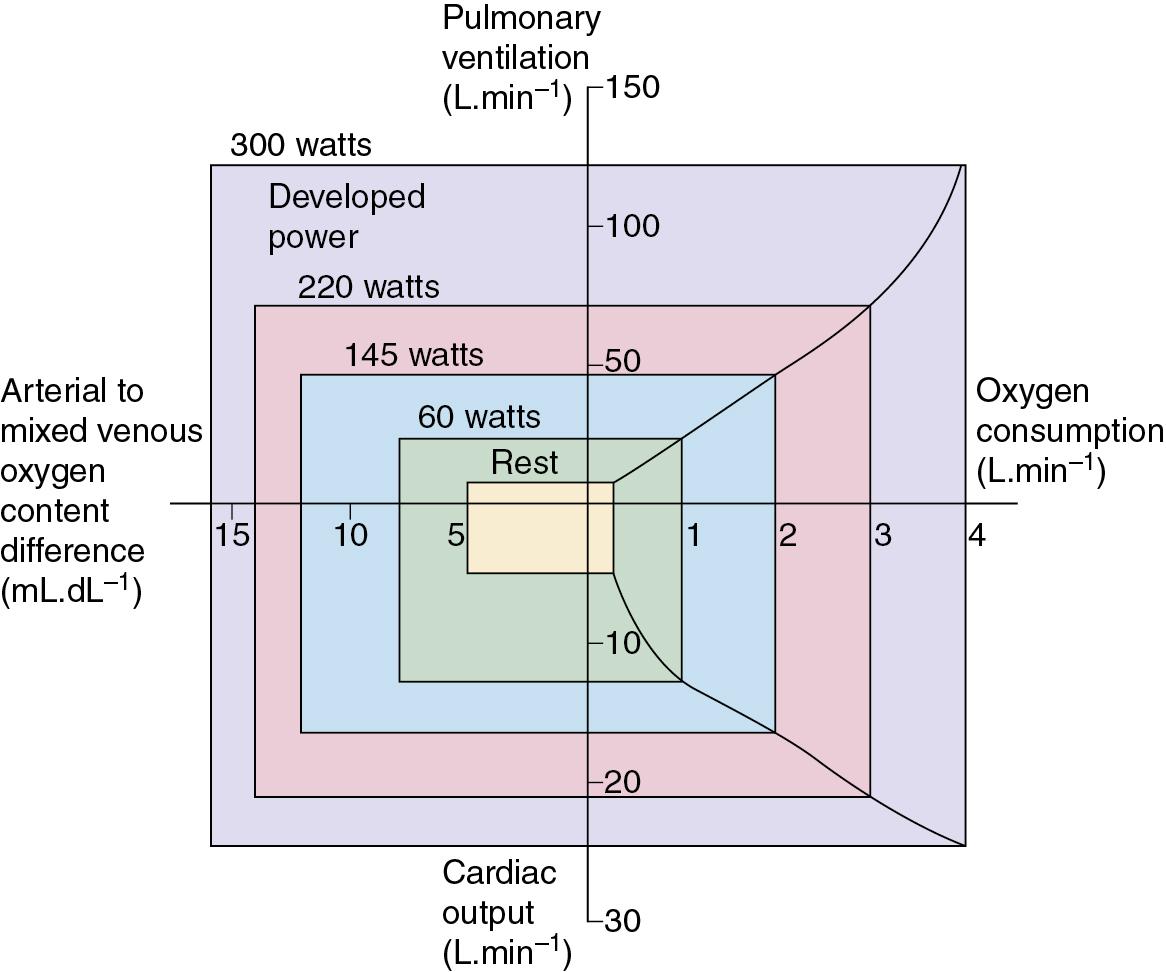Physical Address
304 North Cardinal St.
Dorchester Center, MA 02124
Oxygen consumption increases linearly with the power expended during exercise.
The extra tissue oxygen requirement is provided by increases in cardiac output and blood oxygen extraction.
To accommodate these changes ventilation also increases linearly with exercise—this response occurs the moment exercise begins.
With increasing exercise intensity, lactate is produced from anaerobic muscle metabolism, and blood lactate levels increase, initially reaching a steady state but continuing to rise in severe exercise.
The respiratory response to exercise depends on the level of exercise performed, which can be conveniently divided into three grades:
Moderate exercise is below the subject’s anaerobic threshold (AT; see later), and the arterial blood lactate is not raised. The subject is able to transport all the oxygen required and remain in a steady state.
Heavy exercise is above the AT. The arterial blood lactate is elevated but remains constant. This too may be regarded as a steady state.
Severe exercise is well above the AT, and the arterial blood lactate continues to rise. This is an unsteady state, and the level of work cannot be sustained for long.
There is a close relationship between the external power that is produced and the oxygen consumption of the subject ( Fig. 13.1 ). The oxygen consumption at rest (the basal metabolic rate) is of the order of 200 to 250 mL.min −1 . As work is done, the oxygen consumption increases by approximately 12 mL.min −1 per watt. Exercise intensity is commonly described in terms of metabolic equivalents (METs), which refer to the number of multiples of the normal resting oxygen consumption for that subject. For example, walking briskly on the level requires an oxygen consumption of about 1 L.min −1 , or 4 METs, whereas running at 12 km/h (7.5 mph) requires about 3 L.min −1 of oxygen and is rated as 12 METs of activity. Further examples are shown in Figure 13.1 .

Oxygen consumption rises rapidly at the onset of a period of exercise, with an accompanying increase in carbon dioxide production and a small increase in blood lactate. With moderate exercise ( Fig. 13.2 , A ) a plateau is quickly reached, and the lactate level remains well below the normal maximum resting level (<3.5 mmol.L −1 ). With heavy exercise ![]() o 2 (oxygen consumption),
o 2 (oxygen consumption), ![]() co 2 (carbon dioxide production) and lactate all increase more quickly, again reaching constant levels within a few minutes, the magnitude of which relates to the power generated and the fitness of the subject ( Fig. 13.2 , B ). If the level of exercise exceeds approximately 60% of the subject’s maximal exercise ability (see later), there is usually a secondary ‘slow component’ to the increase in oxygen consumption, associated with a continuing increase in blood lactate level, which ultimately prevents the exercise from continuing ( Fig. 13.2 , C ). There have been many explanations proposed for this slow component of
co 2 (carbon dioxide production) and lactate all increase more quickly, again reaching constant levels within a few minutes, the magnitude of which relates to the power generated and the fitness of the subject ( Fig. 13.2 , B ). If the level of exercise exceeds approximately 60% of the subject’s maximal exercise ability (see later), there is usually a secondary ‘slow component’ to the increase in oxygen consumption, associated with a continuing increase in blood lactate level, which ultimately prevents the exercise from continuing ( Fig. 13.2 , C ). There have been many explanations proposed for this slow component of ![]() o 2 , including increased temperature, the oxygen cost of breathing, lactic acidosis and changes in muscle metabolism secondary to the use of differing fibre types with prolonged exercise. The physiological mechanism underlying the linkage between oxygen requirement by muscles and its delivery during exercise, and the time course of this response, remain incompletely explained.
o 2 , including increased temperature, the oxygen cost of breathing, lactic acidosis and changes in muscle metabolism secondary to the use of differing fibre types with prolonged exercise. The physiological mechanism underlying the linkage between oxygen requirement by muscles and its delivery during exercise, and the time course of this response, remain incompletely explained.

![]() o 2max is the maximum rate of oxygen uptake possible for that subject. A fit and healthy young adult should be able to achieve a
o 2max is the maximum rate of oxygen uptake possible for that subject. A fit and healthy young adult should be able to achieve a ![]() o 2max of about 40 mL.min −1 .kg −1 for female subjects and 48 mL.min −1 .kg −1 for males, which equates to using over 3 L of oxygen per minute for a 70-kg man. However, the type of exercise evoking
o 2max of about 40 mL.min −1 .kg −1 for female subjects and 48 mL.min −1 .kg −1 for males, which equates to using over 3 L of oxygen per minute for a 70-kg man. However, the type of exercise evoking ![]() o 2max varies between subjects, so that where only a single graded exercise test is used, the highest
o 2max varies between subjects, so that where only a single graded exercise test is used, the highest ![]() o 2 recorded represents a peak response,
o 2 recorded represents a peak response, ![]() o 2peak .
o 2peak . ![]() o 2max represents the upper functional limit for that subject, whereas
o 2max represents the upper functional limit for that subject, whereas ![]() o 2peak represents an upper functional limit for that subject during a single test and is the preferred term here. Normal values for
o 2peak represents an upper functional limit for that subject during a single test and is the preferred term here. Normal values for ![]() o 2peak decrease at approximately 8% per decade beyond 30 years of age. A sedentary existence without exercise can reduce
o 2peak decrease at approximately 8% per decade beyond 30 years of age. A sedentary existence without exercise can reduce ![]() o 2peak to 50% of the expected value. Conversely,
o 2peak to 50% of the expected value. Conversely, ![]() o 2peak can be increased by regular exercise, and athletes commonly achieve values of 5 L.min −1 . The highest levels (>6 L.min −1 ) are attained in rowers, who use a greater muscle mass than other athletes, and require an impressive respiratory effort such as a minute volume of 200 L.min −1 (tidal volume 3.29 L at a frequency of 62 breaths per minute).
o 2peak can be increased by regular exercise, and athletes commonly achieve values of 5 L.min −1 . The highest levels (>6 L.min −1 ) are attained in rowers, who use a greater muscle mass than other athletes, and require an impressive respiratory effort such as a minute volume of 200 L.min −1 (tidal volume 3.29 L at a frequency of 62 breaths per minute).
![]() o 2peak is commonly used in exercise physiology as a measure of cardiorespiratory fitness. Subjects undertake a period of graduated exercise, whereas
o 2peak is commonly used in exercise physiology as a measure of cardiorespiratory fitness. Subjects undertake a period of graduated exercise, whereas ![]() o 2 is measured continuously by a spirometric method (page 161). In all but severe exercise, within a few minutes
o 2 is measured continuously by a spirometric method (page 161). In all but severe exercise, within a few minutes ![]() o 2 reaches a plateau ( Fig. 13.2 ), which is the subject’s
o 2 reaches a plateau ( Fig. 13.2 ), which is the subject’s ![]() o 2peak . At higher levels of exercise, as seen in athletes, defining when maximal oxygen uptake is reached may be difficult because of the slow component of oxygen consumption. Elite athletes rarely reach a satisfactory plateau in
o 2peak . At higher levels of exercise, as seen in athletes, defining when maximal oxygen uptake is reached may be difficult because of the slow component of oxygen consumption. Elite athletes rarely reach a satisfactory plateau in ![]() o 2peak , and secondary criteria such as high plasma lactate levels or a raised respiratory exchange ratio may be used to define
o 2peak , and secondary criteria such as high plasma lactate levels or a raised respiratory exchange ratio may be used to define ![]() o 2peak . At
o 2peak . At ![]() o 2peak in trained athletes, approximately 80% of the oxygen consumed is used by locomotor muscles. With the high minute volumes seen during exercise, the oxygen consumption of respiratory muscles also becomes significant, and is around 5% of total
o 2peak in trained athletes, approximately 80% of the oxygen consumed is used by locomotor muscles. With the high minute volumes seen during exercise, the oxygen consumption of respiratory muscles also becomes significant, and is around 5% of total ![]() o 2 with moderate exercise and 10% at
o 2 with moderate exercise and 10% at ![]() o 2peak ( Fig. 13.1 ).
o 2peak ( Fig. 13.1 ).
A 10- or 20-fold increase in oxygen consumption requires a complex adaptation of both circulatory and respiratory systems.
Oxygen delivery is the product of cardiac output and arterial oxygen content (page 155). The latter cannot be significantly increased, so an increase in cardiac output is essential. However, the cardiac output does not, and indeed could not, increase in proportion to the oxygen consumption. For example, an oxygen consumption of 4 L.min −1 is a 16-fold increase compared with the resting state. A typical cardiac output at this level of exercise would be only 25 L.min −1 ( Fig. 13.3 ), which is only five times the resting value. Therefore there must also be increased extraction of oxygen from the blood. Figure 13.3 shows that the largest relative increase in cardiac output occurs at mild levels of exercise. At an oxygen consumption of 1 L.min −1 cardiac output is already close to 50% of its maximal value.

In the resting state, blood returns to the right heart with haemoglobin 70% saturated. This provides a substantial reserve of available oxygen, and the arterial/mixed venous oxygen content difference increases progressively as oxygen consumption is increased, particularly in heavy exercise when the mixed venous saturation may be as low as 20% ( Fig. 13.3 ). This decrease in mixed venous saturation covers the steep part of the oxygen dissociation curve (see Fig. 10.9 ), and therefore the decrease in P o 2 is relatively less (5–2 kPa, or 37.5–15 mmHg). High levels of blood lactate seen during heavy exercise may contribute to the increase in oxygen extraction by shifting the dissociation curve to the right at a capillary level.
The increasingly desaturated blood returning to the lungs and the greater flow of blood require that the respiratory system transports a larger quantity of oxygen to the alveoli. If there were no increased oxygen transport to the alveoli, the reserve oxygen in the mixed venous blood would be exhausted in one or two circulation times. Fortunately the respiratory system normally responds rapidly to this requirement.
During heavy exercise, the total work exceeds the capacity for aerobic work, which is limited by oxygen transport (see later). The difference is made up by anaerobic metabolism, of which the principal product is lactic acid (see Fig. 10.12 ), which is almost entirely ionized to lactate and hydrogen ions. The AT may be defined as the highest intensity of exercise at which measured oxygen uptake can account for the entire energy requirement. Exercise intensity at the AT depends not only on the power produced, but also on many other factors, including environmental temperature, the degree of training undertaken by the subject and altitude. An additional factor is the muscle groups that are used to accomplish the work, as different skeletal muscle fibres, and therefore muscle groups, have different metabolic products.
During severe exercise the lactate level continues to rise ( Fig. 13.2 , C ) and begins to cause distress at levels greater than 11 mmol.L −1 , 10 times the normal resting level. Lactate accumulation seems to be the limiting factor for sustained heavy work, and the progressive increase in blood lactate results in the level of work being inversely related to the time for which it can be maintained. Thus there is a reciprocal relationship between the record time for various distances and the speed at which they are run.
Become a Clinical Tree membership for Full access and enjoy Unlimited articles
If you are a member. Log in here